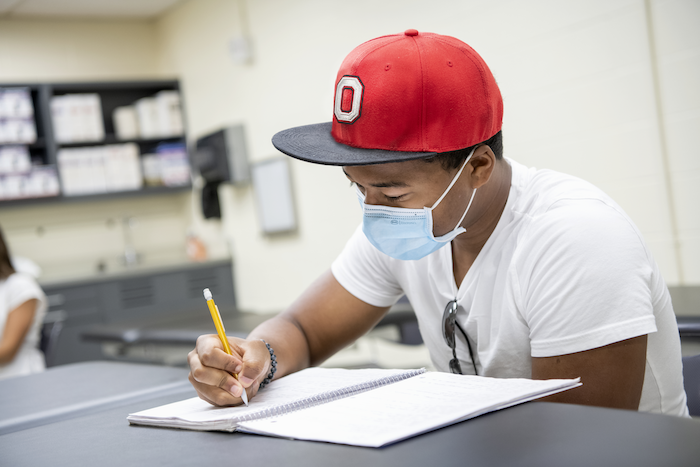Ohio State’s COVID-19 containment efforts appear to be working, experts say
Comprehensive Monitoring Team issues first report
By Misti Crane

In a report published today, the team of experts monitoring the pandemic at The Ohio State University presents evidence that the university’s safety measures are working to contain COVID-19.
Ohio State’s Comprehensive Monitoring Team (CMT) today (Oct. 22, 2020) issued its initial report on ongoing data analysis designed to stem the spread of infection on and around the Columbus and regional campuses. The team of 16 began meeting in August to assess patterns, trends and emerging concerns related to the pandemic. It includes experts in various fields including infectious disease, public health, mathematics and engineering.
Among the CMT’s observations:
- The strategy of frequent testing, isolation, quarantine, masking, distancing and limits on class and gathering size — against the backdrop of less density on campus overall — has been successful in reducing infection rates for undergraduate students living on and off campus. Among graduate and professional students in the testing program, rates have been low.
- Two key measures — trends in infection rates among asymptomatic students and positive rates among students who seek out testing because of symptoms or close contact with someone who is infected — declined and then remained stable since mid-September.
- The reproduction number(Rt), an epidemiological measure of the potential for ongoing transmission, has remained stable, and primarily below 1, an indicator that the epidemic may be slowing.
- The majority of students who have tested positive for COVID-19 have experienced no symptoms.
“It is possible to drive infection down with an infusion of determined university leadership, resources, and effort through close monitoring and focused intervention,” the CMT concludes in the report.
 That optimism comes with a side of caution – particularly as the weather turns colder, sending more people indoors and as some grow complacent about the public health precautions necessary to contain the pandemic, said Amy Fairchild, who leads the CMT and is dean of Ohio State’s College of Public Health.
That optimism comes with a side of caution – particularly as the weather turns colder, sending more people indoors and as some grow complacent about the public health precautions necessary to contain the pandemic, said Amy Fairchild, who leads the CMT and is dean of Ohio State’s College of Public Health.
She stressed the importance of engaged students, faculty and staff who have committed to safety measures — and of redoubling efforts to keep Ohio State going in the right direction.
“Our students have been routinely showing up for testing, participating in the contact tracing process and protecting the Buckeye community through isolation and quarantine – all factors that have contributed to the relative success we’ve seen so far,” Fairchild said.
“Coupled with ongoing measures including proper masking, physical distancing and avoiding crowded gatherings – which are all supported by our public health campaign – I’m optimistic that we can continue to control transmission on and off campus, even as increases in infection rates are being seen in communities throughout the state.”
Looking forward, the CMT is expanding its work monitoring vulnerable populations, activity on Ohio State’s regional campuses and analyzing wastewater, a method of tracking the virus that bolsters overall campus surveillance.
In addition to its near-daily meetings to analyze data, create predictive models and develop recommendations for campus leaders, the monitoring team reviews policies for Ohio State’s Case Investigation and Contact Tracing Team. Members of the CMT also support the Ohio Department of Health’s monitoring efforts.
Along with the expertise of its core members, the team draws on a breadth of skills and knowledge from faculty, students and staff throughout Ohio State.
About The Ohio State University College of Public Health
The Ohio State University College of Public Health is a leader in educating students, creating new knowledge through research, and improving the livelihoods and well-being of people in Ohio and beyond. The College's divisions include biostatistics, environmental health sciences, epidemiology, health behavior and health promotion, and health services management and policy. It is ranked 22nd among all colleges and programs of public health in the nation, and first in Ohio, by U.S. News and World Report. Its specialty programs are also considered among the best in the country. The MHA program is ranked 5th and the health policy and management specialty is ranked 21st.